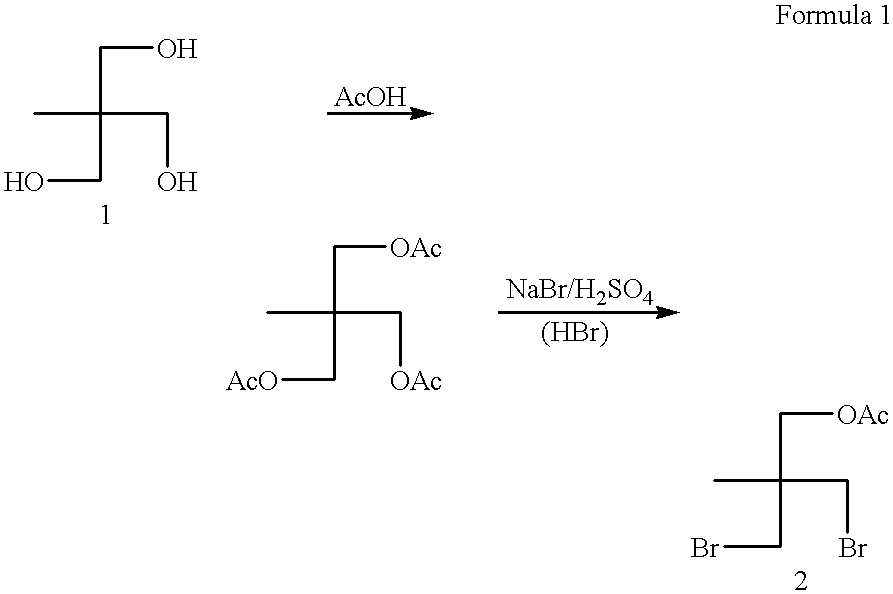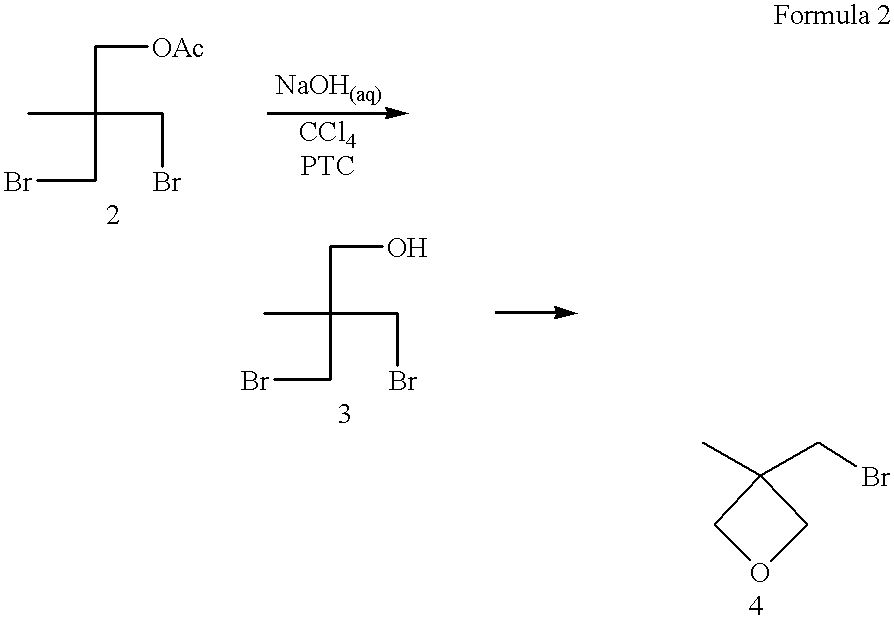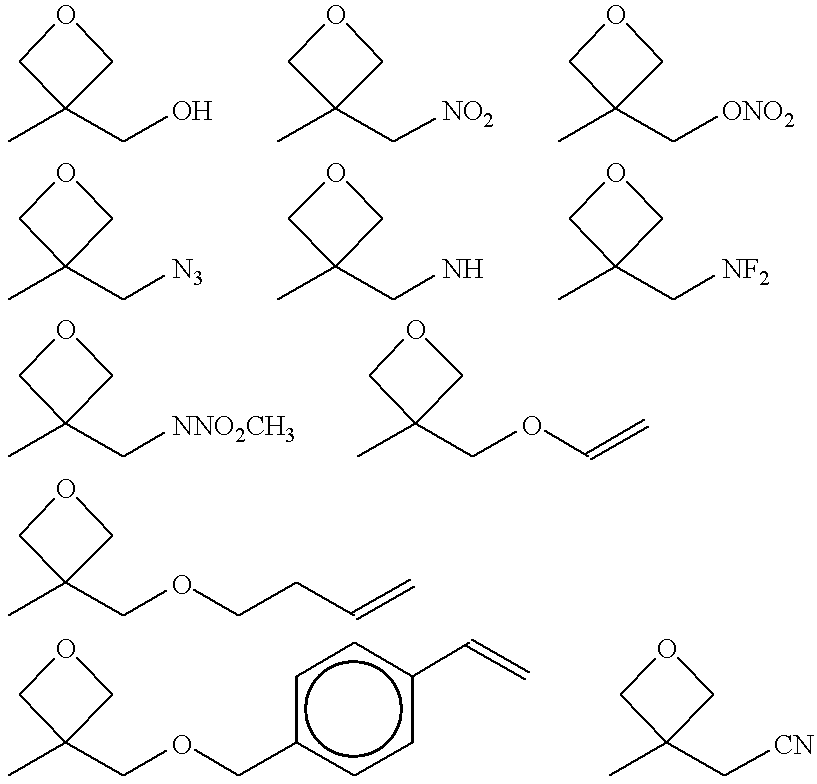Copolymers and coprepolymers formed from mono-substituted fluorinated oxetane monomers and tetrahydrofuran
a technology of fluorinated oxetane monomers and coprepolymers, which is applied in the field of polymer compositions, can solve the problems of difficult application, unsuitable coatings for flexible substrates, and difficult processing of plastics, and achieve low glass transition temperature, good hydrophobic properties, and low surface energy
- Summary
- Abstract
- Description
- Claims
- Application Information
AI Technical Summary
Benefits of technology
Problems solved by technology
Method used
Image
Examples
example a1
Preparation of 3-bromo-2-bromomethyl-2-methylpropyl Acetate
In a 12L flask equipped with an overhead stirrer, reflux condenser, and addition funnel was placed 1,1,1-tris(hydroxymethyl)ethane (TME, 1.000 Kg, 8.32 mol) and glacial acetic acid (3.750 L). The mixture was allowed to stir until partial dissolution of the TME had occurred and then the sodium bromide (2.568 Kg, 24.96 mol) was added with vigorous stirring. The sulfuric acid (1.718 Kg, 16.64 mol) was then slowly added over 6 hours. After the addition was complete, the reaction mixture was heated to 120.degree. C. for 48 hours. At this time GC evidence indicated that the reaction was complete and the mixture was cooled to room temperature and quenched with 7L of ice water. The organic and aqueous phases were separated and the organic was washed with water, 0.5N NaOH (until neutral pH), brine, and then dried over MgSO.sub.4 to yield the product as a clear colorless oil in 92% yield (2.206 Kg): IR (KBr) 2980-2800, 1744, 1374, 124...
example a2
Preparation of BrMMO Pre-monomer 3-Bromomethyl-3-methyloxetane
In a 50 L flask equipped with an overhead stirrer and reflux condenser was placed 3-bromo-2-bromomethyl-2-methylpropyl acetate (2.206 Kg, 7.66 mol), 3M NaOH (7.67 L, 22.98 mol), tetrabutylammonium bromide (123.47 g, 0.383 mol), and CCl.sub.4 (7.66 L). The resulting heterogeneous solution was then refluxed at 70.degree. C. overnight. At this time GC evidence indicated that the reaction was complete. The reaction was then cooled to room temperature. The organic and aqueous phases were separated, the organic phase was washed with water and brine, and then dried over MgSO.sub.4. Removal of the solvent gave the product as a clear, light yellow oil (1.224 Kg) in 97% yield. Distillation gave a clear, colorless oil (1.189 Kg) in 94% yield, bp 46.degree. C. / 0.3 mm Hg; IR (KBr) 2980-2800, 1242, 1201, 1147, 704 cm.sup.-1 ; .sup.1 H NMR .delta. 1.44 (s, 3H), 3.65 (s, 2H), 4.40 (d, J=5.8 Hz, 2H), 4.45 (d, J=5.8 Hz, 2H) .sup.13 C NMR 2...
example a3
Preparation of Pre-monomer p-Toluenesulfonate of 3-Hydroxymethyl-3-methyloxetane
A solution of 3-hydroxymethyl-3-methyloxetane (612 g, 6 mol) in pyridine (800 ml) was cooled to -10.degree. C. and treated, slowly, with a solution of p-toluenesufonyl chloride (1364 g, 7 mol) in pyridine (700 ml). The rate of addition was maintained so that the contents of the flask were kept below -5.degree. C. Upon complete addition, the solution temperature was held at -5.degree. C. for 30 minutes and then at room temperature for 2 hours. The contents of the flask were quenched by pouring it into ice water (10 L), and the precipitated solid was filtered, washed with water and dried in air. The purity of the product as determined by GLC analysis was >98%. By this method, 1352 g of the desired product was obtained, representing an 88% yield.
The yield and purity of the bromomethyl and arylsulfonate premonomer product are extremely high and these examples clearly show how easily and inexpensively the mon...
PUM
| Property | Measurement | Unit |
|---|---|---|
| polydispersity | aaaaa | aaaaa |
| glass transition temperatures | aaaaa | aaaaa |
| surface energy | aaaaa | aaaaa |
Abstract
Description
Claims
Application Information
 Login to View More
Login to View More - R&D
- Intellectual Property
- Life Sciences
- Materials
- Tech Scout
- Unparalleled Data Quality
- Higher Quality Content
- 60% Fewer Hallucinations
Browse by: Latest US Patents, China's latest patents, Technical Efficacy Thesaurus, Application Domain, Technology Topic, Popular Technical Reports.
© 2025 PatSnap. All rights reserved.Legal|Privacy policy|Modern Slavery Act Transparency Statement|Sitemap|About US| Contact US: help@patsnap.com



